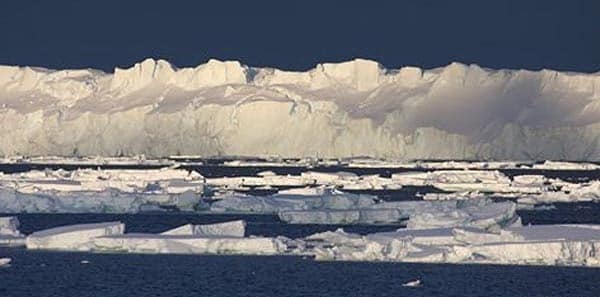
The Totten Glacier is 120 kilometres long and 30 kilometres wide. If it melts completely, it alone could raise global sea levels by 6 metres.
by Simon Butler
Green Left Weekly
Scientists had long thought the giant East Antarctic ice sheet was barely affected by global warming and that its glaciers were stable. It turns out those assumptions were wrong.
A team of scientists returned on January 26 from a 7-week expedition to East Antarctica with the bad news: warm ocean water is melting the huge Totten glacier from below.
Totten is East Antarctica’s largest glacier. It drains an area more than double the size of Victoria and holds enough ice to cause a 6-metre sea-level rise.
The expedition’s chief scientist Dr Steve Rintoul said the voyage was carried out after satellite data suggested the glacier was retreating much faster than expected. They found that the glacier rests on below-sea-level bedrock, making it more susceptible to the warmer-than-normal ocean currents melting it from beneath.
Very significant ice losses have been recorded in the western part of the Antarctic continent in recent years. In May, NASA glaciologist Eric Rignot said: “A large sector of the West Antarctic ice sheet has gone into a state of irreversible retreat. It has passed the point of no return.” He said the region’s ice melt will raise sea levels by 1.2 metres. The ice may still take two centuries to melt completely, but Rignot warned “the retreat of [west Antarctica’s] ice is unstoppable.”
The new East Antarctica results are an added shock because its far-larger ice sheet appeared to be thickening due to increased snowfall. Rintoul said: “It was thought that glaciers on the East Antarctic ice sheet were relatively immune to the kind of melting taking place on the much smaller West Antarctic ice sheet.”
The most recent International Panel on Climate Change (IPCC) report does not include evidence from these recent studies. Even so, the IPCC found that the ice loss from the Antarctic ice sheet had likely risen from 30 billion tonnes a year between 1992 and 2002 to 147 billion tonnes between 2002 and 2011: roughly a 5-fold increase.
The ice melt in Greenland is even more dramatic. Over the same time periods, the IPCC said Greenland’s ice loss rose from 34 billion tonnes a year to 215 billion tonnes.
Although higher air temperatures play a part, it’s the warmer ocean temperatures that are most responsible for the retreat of Antarctica’s massive glaciers. About 93% of the extra heat retained by higher carbon emissions ends up in the oceans. Since the 1970s, the heat content of the world’s oceans has risen steadily.
Last year set a new record. Ocean temperatures in 2014 rose so much that the US National Oceanic and Atmospheric Administration will have to re-scale its ocean heat graph.
The ongoing rise in ocean temperatures over the past few decades also blows away the claim – often made by climate deniers – that global warming paused for a period. It has never paused, and global ocean temperatures prove it.
It is not just ocean warming that is setting alarming new records though. On February 2, the World Meteorological Organisation (WMO) confirmed that 2014 was the hottest year ever recorded for global air temperatures. It also said that 14 of the 15 hottest years have all been this century (the other year was 1998).
WMO secretary-general Michel Jarraud said: “The overall warming trend is more important than the ranking of an individual year … we expect global warming to continue, given that rising levels of greenhouse gases in the atmosphere and the increasing heat content of the oceans are committing us to a warmer future.”


